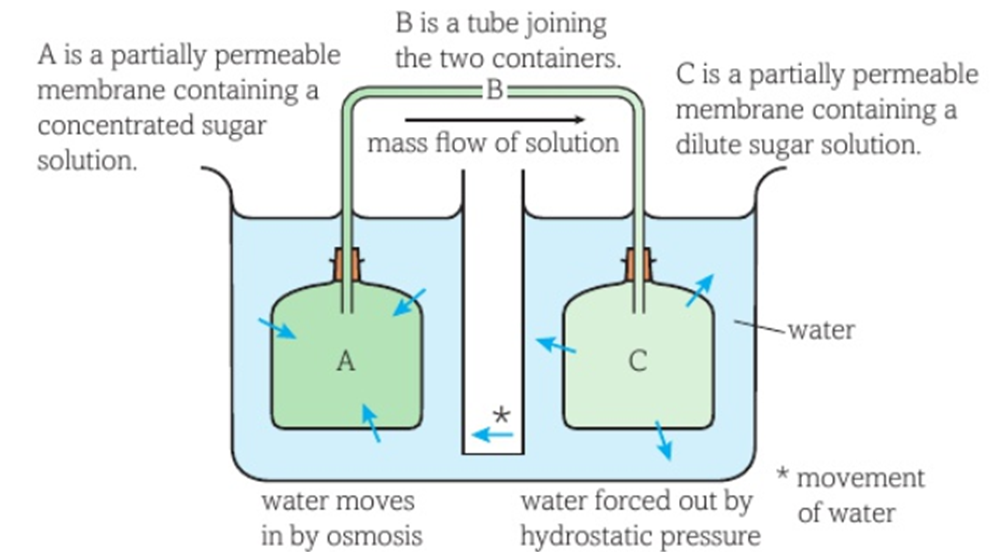3. translocation of sucrose
1/10
There's no tags or description
Looks like no tags are added yet.
Name | Mastery | Learn | Test | Matching | Spaced |
|---|
No study sessions yet.
11 Terms
TRANSPORT IN PHLOEM
movement of substances in phloem tissue is called translocation
main substances that are moved are sucrose and AAs, which are in solution in water
these substances have been made by plant and are called assimilates
sucrose is the main assimilate
glucose made by photosynthesis is converted into sucrose for transport because sucrose has less of an osmotic effect
SOURCES AND SINKS
vascular plants produce sucrose in their leaves
then transported to rest of the shoot or to the root tips, where growth occurs
leaves are referred to as the source, and shoot and root tips- sink
source- organ that produces more sugar than it requires-where assimilates enter the phloem
sink- organ that consumes sugar for its own growth and storage- where assimilates leave phloem
PHLOEM LOADING
sucrose is loaded into phloem sieve elements from surrounding cell
very effective process
2 main loading routes:
symplast pathway
apoplast pathway
PHLOEM LOADING- SYMPLAST PATHWAY
sucrose moves by diffusion down a conc gradient from source cells through cytoplasm of other cells into companion cells then into phloem sieve tubes
lowers the water potential in tube so water moves in by osmosis
generates a pos hydrostatic pressure which moves the phloem sap towards the sinks so a constant conc gradient is maintained
PHLOEM LOADING- APOPLAST PATHWAY
sucrose moves by diffusion through cellulose cell walls and cell spaces to the companion cells
in companion cells sucrose is moved from wall spaces across membrane into cytoplasm by active transport using ATP
produces a high conc of sucrose in companion cells and so it moves into sieve tubes through many plasmodesmata
water moves into companion cells by osmosis producing a high hydrostatic pressure
moves assimilates and water into and through sieve tubes
hydrostatic pressure moves sucrose towards sinks where pressure is lower
PHLOEM UNLOADING
phloem sap is unloaded into sink cells by diffusion from sieve tubes
sucrose then moves into other cells by diffusion and may be converted into other compounds (e.g. starch)
maintains conc gradient between phloem and sink cells
as sucrose moves out of sieve tubes water potential of phloem sap rises so water moves out by osmosis
some moves into xylem
SUMMARY- dont bother but yeah
Glucose is made by photosynthesis in source cells and converted into sucrose.
The sucrose moves down the symplast pathway by diffusion though plasmodesmata to companion cells and into the phloem.
Some sucrose also moves via the apoplast pathway by diffusion into the cell walls of the companion cells. This is then actively pumped into the cytoplasm of the companion cells and moves into the phloem.
The movement of sucrose into the phloem lowers the water potential beside the source cells.
Water moves into the phloem from the nearby xylem vessels down the water potential gradient.
This creates a higher hydrostatic pressure here so the phloem sap moves down the phloem towards sink cells where pressure is lower.
at the sink cells sucrose moves into cells by diffusion and is converted into starch. This maintains the concentration gradient.
The removal of sucrose increases the water potential in the phloem so water moves back into the xylem down a water potential gradient.
EVIDENCE FOR TRANSLOCATION
radioactive isotopes (carbon-14) can be made available to leaves of plants so they are used to make glucose in photosynthesis
sucrose made from this glucose is also labelled and path it takes through a plant can be traced using autoradiography
labelled sucrose is found in phloem
if steam is used to kill a full outer ring of bark in a young shoot, just below a leaf, movement in phloem stops
movement of water in xylem is not affected
aphids (green fly) penetrate phloem tubes with their mouth parts to access sucrose
sometimes pressure of phloem sap is so great it moves though the aphids digestive system and appears as a drop at the end of its body- if aphid is removes sap oozes out
MASS FLOW HYPOTHESIS- WHO
mass transport= transport of materials from one point to another in a transport system using a transport medium and pressure or a force to bring about movement
translocation fulfils all of these
1930- Ernst Munch developed a simple mass transport hypothesis to movement of solutes in phloem of plants
MASS FLOW HYPOTHESIS
water moves into both containers by osmosis
as A has a much higher conc of sugar than C water moves in more rapidly so there is a flow of solution from A to C
hydrostatic pressure this makes forces water out of C
flow continues until the concentrations in A and C are equal

MASS FLOW HYPOTHESIS- LIMITATIONS
doesn’t take into account active loading of sucrose into phloem by companion cells at the source- changes conc gradient and can even change direction of flow
translocation is continuous (doesn’t end when concentrations are equal) model doesn’t take into account continuous loading of sucrose from sources and removal at sinks that make it possible
water can move into sieve tubes at any point by osmosis
return route for water to the cells is xylem- not represented in model